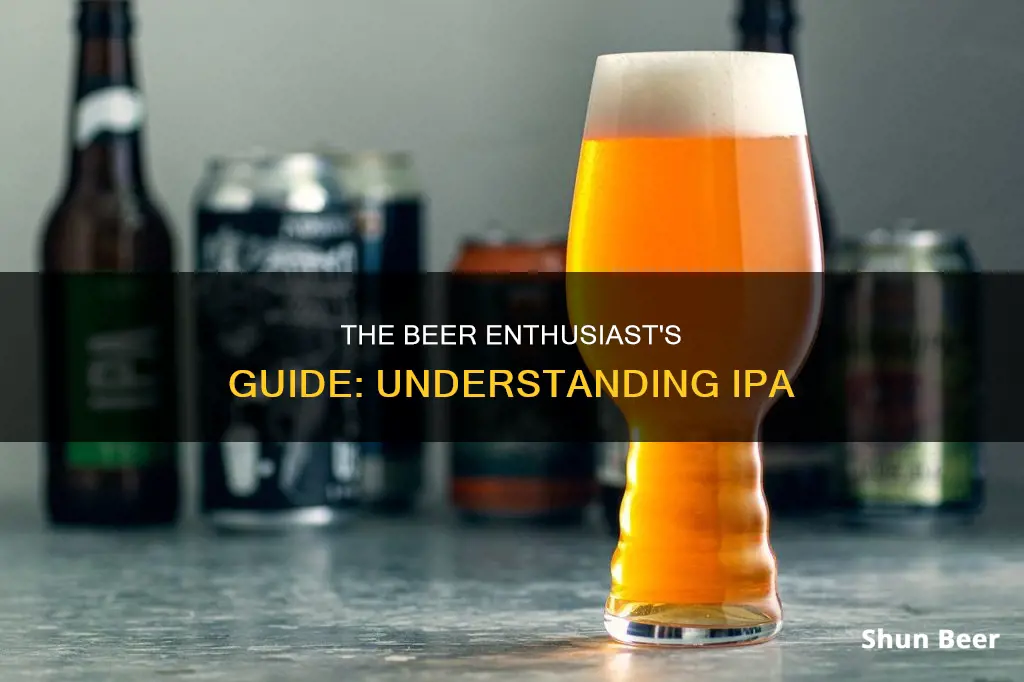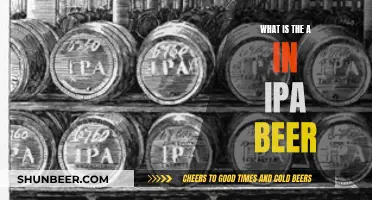
If you're a beer lover, you've probably heard of IPA. It stands for Indian Pale Ale or India Pale Ale, a style of beer that's become increasingly popular over the last few decades. The history of the IPA dates back to the 18th century and the British Empire. The story goes that it was brewed to be easy to preserve on long voyages from Britain to India. It had a higher level of hops, which acted as a preservative, and a higher alcohol content, which helped it last during the four-to-six-month journey. Today, IPAs are known for their hoppy flavour and typically have a higher ABV than most other beers.
What You'll Learn
- IPA stands for India Pale Ale, a beer style that emerged in the 1780s
- IPAs are characterised by a strong hoppy flavour, with higher levels of hops added during brewing
- The style was originally developed to preserve beer during long voyages from Britain to India
- There are many variations of IPAs, including hazy, double, imperial, and session IPAs
- The popularity of IPAs is often attributed to the craft beer movement, particularly in the US and UK

IPA stands for India Pale Ale, a beer style that emerged in the 1780s
IPA is an acronym and is pronounced as I-P-A. The three letters stand for India Pale Ale, which is the full name of the style. The term "ale" refers to top-fermented beer, a type of beer that traditional British breweries have always been experts in. In the United Kingdom, the term "ale" also refers to the classic beers of the past, which are still made by many small independent brewers. "Pale" can be interpreted literally as "light-coloured". Pale ales emerged in the 18th century due to innovations in the malting process, and their amber colour set them apart from the dark beers that dominated the market at the time.
India Pale Ale (IPA) emerged in the 1780s. The style was pioneered by London-based brewer Hodgson, who had built a solid business around the demand for beer in the British colonies in India. Hodgson realised that some of his existing pale ales—which were hoppier and stronger than usual—were particularly suited to long sea travels and could survive the journey to the Indian colonies. Hops are a powerful natural preservative, and the high alcohol content in these beers also helped them to last longer.
A few years later, Hodgson's son came into conflict with the East India Company, allowing other breweries to access the market. Brewers in Burton-on-Trent, a small town in today's Staffordshire, adapted their recipes to create their own versions of Hodgson's pale ales. These specific versions of pale ales became known as India Pale Ales (IPAs).
The popularity of IPAs continued to grow, and by the 1860s, they were widely brewed in England and were much more attenuated and hopped than porters and ales. In modern times, the style has experienced a renaissance and is now one of the most sought-after beer varieties.
The Harp: Guinness Beer's Musical Instrument Trademark
You may want to see also

IPAs are characterised by a strong hoppy flavour, with higher levels of hops added during brewing
The acronym IPA stands for Indian Pale Ale or India Pale Ale. IPAs are characterised by a strong hoppy flavour, with higher levels of hops added during brewing.
Hops are one of the four essential ingredients in beer. They help to balance the sweetness of the residual sugars and keep the beer from spoiling. Hops can also add bitterness, aroma, and flavour to the beer. The level of bitterness can be adjusted by the type of hop, the amount used, and how it is used.
When it comes to IPAs, the hops are added to showcase the hop flavour and aroma. The hops can be added early or late in the brewing process, which will affect the flavour of the beer. Hops added early in the process will contribute more to the bitterness of the beer, while hops added late will add more flavour and aroma.
There are different types of IPAs that will showcase the hoppy flavour in different ways. A traditional West Coast IPA is hoppy, fruity, and crisp, and may have some bitter varieties. A New England-style IPA is very hazy and has intense fruit flavours and a grassy aroma. It is also fermented to have lower carbonation. A British IPA is very hoppy and one-note, without the burst of fruit found in other IPAs.
The different types of hops used and the timing of when they are added during brewing will create distinct flavour profiles for each type of IPA. For example, classic American hops like Cascade, Centennial, and Chinook taste of bitter fruit, pine, and resin. On the other hand, newer varieties like Citra, Galaxy, Mosaic, and Simcoe taste of sweet fruit like tropical fruit, stone fruit, berry, and melon.
So, when talking about beer, the acronym IPA refers to Indian Pale Ale or India Pale Ale, which is characterised by a strong hoppy flavour due to the higher levels of hops added during the brewing process.
Guinness Beer Tanks: What's the Perfect Container?
You may want to see also

The style was originally developed to preserve beer during long voyages from Britain to India
India Pale Ale (IPA) is a hoppy beer style within the broader category of pale ales. The style was originally developed in the 18th century to preserve beer during long voyages from Britain to India, then under the control of the British Empire.
During the colonial era, sailors and brewers struggled to find a way to prevent beer from spoiling during the journey from England to British colonies in India. Beer stored in large casks, called hogsheads, would spoil and go flat during the journey as it was exposed to warmer temperatures while being jostled in the ship's hull.
By the 1760s, breweries discovered that adding extra hops to their beers helped to preserve them for the voyage to warmer climates. Not only were they adding hops to pale ales, but also to porters and ales. The extra hops gave the beer a bitter taste, and the higher alcohol content made it more refreshing in the hot Indian climate compared to the dark ales and porters that were popular in London.
George Hodgson, a brewer at the Bow Brewery in East London, was among the first to export beer to India. His beers became popular among East India Company traders due to their proximity to the East India Docks and his liberal credit line of 18 months. However, the East India Company eventually sought new brewing partners due to Hodgson's unscrupulous business practices.
They found new partners in Burton upon Trent, where brewers had recently lost their valuable export markets in Russia after it was banned by the Tsar. The Allsopp, Bass, and Salt breweries improved upon Hodgson's recipe for hopped pale ale and took over the Indian market.
The first known recorded mention of the phrase "India Pale Ale" was in 1835 in an edition of the Liverpool Mercury. By the 1840s, India Pale Ale had become one of England's best-selling beers, and its popularity continued to grow in the following decades.
Today, the IPA has evolved into its own unique style, with a wide range of variations, including West Coast IPA, East Coast IPA, New England IPA, and more. While modern IPAs are typically enjoyed fresh and cold, the style was originally developed to withstand the long journey from Britain to India during the colonial era.
Abita Beer's Exploration of IPAs: A Comprehensive Guide
You may want to see also

There are many variations of IPAs, including hazy, double, imperial, and session IPAs
The IPA, or India Pale Ale, is a style of beer that has spawned many variations. The original IPAs were British IPAs, which were hoppy golden ales with a grassy, earthy, and light citrus character. They were created in the 18th century to survive the long voyage from England to British colonies in India.
Over time, different variations of IPAs have emerged, including:
- Hazy or New England IPAs: These IPAs are known for their cloudy appearance and juicy, fruity flavours, often including pineapple, mango, and other bright, sweet notes. They are less bitter than other IPAs and are considered more approachable and ideal for newcomers to craft beer.
- West Coast IPAs: Originating in California, these IPAs have a piney aroma with citrus and earthy notes. They tend to be more bitter and have a sharper, more assertive flavour than New England IPAs.
- Double or Imperial IPAs: These IPAs have a higher alcohol content and a stronger hop flavour. They use more malt to balance out the increased bitterness, resulting in an ABV typically over 7%.
- Session IPAs: Designed for casual drinking, session IPAs have a lower alcohol content (around 4-5% ABV) and a more subtle flavour profile. They are lighter in body but still retain a strong hoppy aroma, making them perfect for enjoying multiple beers in one sitting.
Other less common variations of IPAs include Triple IPAs, East Coast IPAs, Black IPAs or Cascadian Dark Ales, Belgian IPAs, and Sour IPAs. Each of these styles offers unique flavour profiles, appearances, and drinking experiences, showcasing the versatility and creativity of craft brewers.
Organic Beer: Is IPA the Healthier Choice?
You may want to see also

The popularity of IPAs is often attributed to the craft beer movement, particularly in the US and UK
India Pale Ale (IPA) is a hoppy beer style within the broader category of pale ale. The popularity of IPAs is often attributed to the craft beer movement, particularly in the US and UK.
IPAs have a long history dating back to the 1780s, when they were first brewed in the UK and became popular among British soldiers and administrators serving in India. However, by the 1990s, IPAs had fallen out of fashion and were hard to find in British bars. The craft beer movement brought IPAs back into the spotlight, with craft brewers experimenting with new styles and flavours. This new wave of IPAs became synonymous with innovation and artisanal brewing, and they quickly gained a dedicated following.
The unique flavour profiles of IPAs also contributed to their popularity. Known for their distinct bitterness and higher alcohol content, IPAs offer a range of styles and flavours that cater to different taste preferences. From light and easy-drinking Session IPAs to bold and punchy West Coast IPAs, there is an IPA for everyone. The versatility of the style encourages continuous experimentation among brewers, leading to unique and exciting flavour profiles that keep enthusiasts coming back for more.
The strong link between IPAs and the craft beer movement is another factor in their popularity. As more craft breweries emerged, they began to produce their own IPAs, making this style of beer synonymous with the craft beer world. IPAs became a staple in the American craft beer scene, with their widespread availability, consistently good quality, and unique appearance.
During the craft beer boom of the 2010s, IPAs experienced a significant rise in popularity. With many microbreweries experimenting and creating unique spins on this classic style, the market was flooded with various IPAs, capturing the attention of beer enthusiasts and casual drinkers alike. The increase in production and variety sparked a love for hops and bitterness that continues today.
In summary, the popularity of IPAs is largely attributed to the craft beer movement, especially in the US and UK. The unique flavours, consistent quality, and strong association with craft brewing have made IPAs a favourite among beer lovers, and their popularity shows no signs of waning.
Beer and Potassium: IPAs and Their High Potassium Content
You may want to see also
Frequently asked questions
IPA stands for Indian Pale Ale or India Pale Ale.
During the British colonial era, sailors needed a beer that could survive the long journey from Britain to India. The weather in India was too hot and humid to brew beer, so they made a beer with lots of hops that could survive the voyage without spoiling.
There are many types of IPAs, including West Coast IPA, New England IPA, Session IPA, British IPA, Double IPA, and Triple IPA.
IPAs are known for their bold and bitter taste, with strong hop flavours and aromas. However, they can also be refreshing and fruity, light and crisp, or heavy and intense.
IPAs are full of flavour and offer a unique drinking experience compared to other beers. They have become synonymous with the craft beer movement, and their popularity has grown as craft beer has become more widespread.







